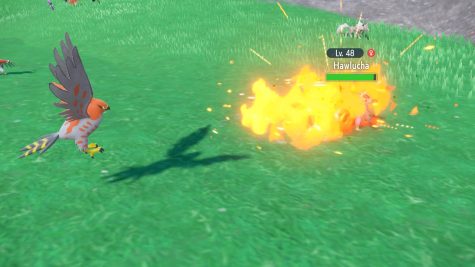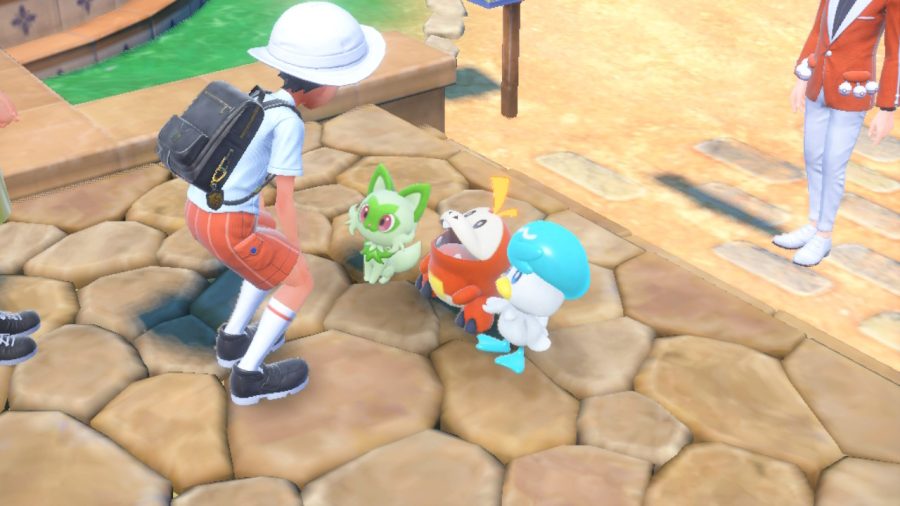Upon the announcement of the ninth generation of Pokémon games, I felt somewhat indifferent after finding the previous games, “Pokémon Sword and Shield,” fun but merely satisfactory. Now that I have played the game, it exceeded my expectations, yet still suffers due to an egregious amount of glitches and performance issues. However, “Pokémon Scarlet and Violet” is easily one of the best Pokémon experiences to come out in a long time, despite the technical issues.
“Scarlet and Violet” both take place in the Paldea region, where you as the player go on a journey as part of an independent study program for your school, Naranja Academy in “Scarlet,” and Uva Academy in “Violet.”
These titles take the franchise into a fully open world. This shift by nature makes Paldea the biggest region to date, taking approximately 21 minutes to complete a lap around the map on the main road while riding your mount Pokémon.
Like most open world games, if you can see a landmark, there is nothing stopping you from going there… Well, almost nothing in Pokémon’s case. The primary obstacle preventing you from going anywhere is the traversal capabilities of your mount, which is also the Pokémon on the game’s cover – Koraidon in “Scarlet” and Miraidon in “Violet.” Although you can reach every area as soon as the world opens up, you cannot traverse terrain such as open water or high cliffs until you have made certain progress in the story.
The story of the game is split into three different storylines that cover the individual aspects of a traditional Pokémon story. You can tackle story objectives in any order, but the strength of enemy trainers and Pokémon do not scale with the number of objectives you complete.
Victory Road is the longest storyline with eight main objectives. It covers the familiar gym challenge from past games, in which players visit eight Pokémon gyms to receive gym badges and ultimately take on the Pokémon League and become Champion. While I found this to be the least interesting of the three stories, it still serves its purpose and provides a refreshing take on the classic formula.

Path of Legends is the next storyline and was by far my favorite. This features you and an upper-classman named Arven taking on five Titan Pokémon in search of the legendary Herba Mystica. After each Titan is defeated and the different kinds of Herba Mystica found, your mount will gain new abilities which allow you to traverse more of the world. Abilities such as swimming, climbing and gliding are three of the five abilities unlocked as you progress through the story.
The third storyline is Starfall Street, in which you deal with Team Star, the games’ team of antagonists. This storyline surprised me with its compelling characters and many emotional moments.
“Scarlet and Violet” bring various changes that improve the overall gameplay. For example, animations such as throwing a Pokéball and catching a Pokémon have been heavily sped up. Other quality of life changes include a vastly improved tutorial, a clean user interface both in and out of battle, and few menus to flip through. While the fundamental gameplay during battles is largely unchanged from other mainline titles, there are some new elements.
The game introduces a new battle mechanic called terastallization, which makes a Pokémon take on a crystalline appearance and gain a head adornment based on one of the 18 different Pokémon types. Once transformed, the Pokémon will become that single type and attacks of that type will be significantly powered up. Terastallization allows for strategic opportunities such as changing the strengths and weaknesses of a team member, or boosting the strength of a move so that it will knock out the enemy on the next turn.
Unlike previous battle gimmicks, terastallization can only be used once. In order to do so again, you must heal your Pokémon at a Pokémon Center. This limitation allows for the mechanic to be less intrusive than mega evolution or z-moves from “X and Y” and “Sun and Moon” respectively but also frequently usable if desired unlike dynamaxing from “Sword and Shield.”
Wild Pokémon are visible at all times and players initiate battle by interacting with them. Pokémon in the air can be encountered by throwing your own Pokémon at them with the ZR button. The player can also catch wild Pokémon off guard by sneaking behind them and throwing a Pokémon. Wild Pokémon caught off guard will not be able to act on their first turn.
While I enjoyed seeing the world alive during battles, sometimes a wild Pokémon would wander through the battlefield and I would be positioned in a spot where a battle will end but I immediately enter battle again. This got annoying at times when I just wanted to move on to my next objective.
Enemy trainers no longer initiate battle when you pass in front of them. In “Scarlet and Violet,” non-player characters (NPCs) in the world will have small text boxes above their heads and interacting with them will initiate the battle. Making enemy trainers optional led me to ignore most of them, however, to resolve this one Pokémon Center in each area will have an NPC that gives you a reward such as a Technical Machine (TM) for battling a certain number.
The game also adds co-op for the first time. Up to four players can play online in the same space at once. While I played “Scarlet,” the rest of my friends were playing “Violet” and we found that everyone could find wild Pokémon exclusive to each version while in co-op. I thoroughly enjoyed this feature because while it largely disincentivized trading, it still encouraged playing with owners of the opposite game version.
Although distant textures can lack detail, there are times when the game looks gorgeous. A couple examples include scaling a cliff atop your mount with the game’s lighting focused on where you’re climbing, or the way sunlight will reflect on the ocean at sunset.
Another improvement in the visuals is that all Pokémon have been retextured to give the appearance of scales or fur. Even metallic looking Pokemon have been given a reflective surface.
In terms of player customization, the amount of options for eyes and hair have been drastically increased. However, while players can still equip accessories such as hats, glasses, gloves and bags, in terms of main clothing, the only options are four different seasonal school uniforms, and you can only wear one at a time.
With all that said, the game suffers from major performance issues. While it was somewhat minor for me and never ruined my experience, it was very noticeable. The game wasn’t held together by the seams, but it did indeed have issues. These issues, from my experience, include an unstable frame rate, egregious pop-in (environment features and Pokémon appearing late), shading that suddenly vanishes, the camera clipping into the floor and the extremely rare crash.
Another issue is sometimes I would head toward a Pokémon on the field with a rare tera type, only for it to vanish as I would approach it; I played the game in handheld mode which is supposed to be better with this issue than docked mode. The game also crashed on me, once, but that was when I was playing with a full group. Overall, I found that the game is much smoother offline than online.
Despite the performance issues, I still had a blast playing through “Pokémon Scarlet.” The game shakes up the formula of the mainline games enough to be familiar yet refreshing, and tells a surprisingly good story that features wonderful characters, catchy music and overall fun gameplay. It’s a shame that the game suffers from poor performance because this is otherwise the best new Pokémon experience in a long time.
If performance issues won’t hinder your enjoyment, then I highly recommend “Pokémon Scarlet and Violet.” However, if it will affect your appreciation of the game, then I say wait for a patch that irons out these wrinkles in an otherwise stellar game.





